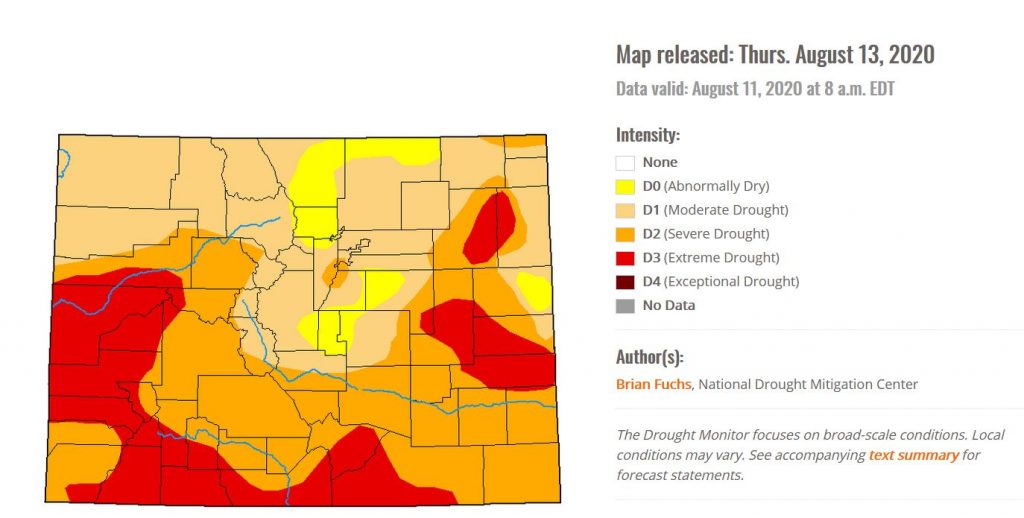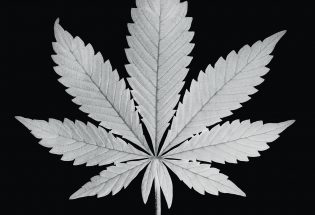Drought conditions set in across Colorado

By Amber McIver-Traywick
The Surveyor
Hot and extremely dry conditions over the past several months have resulted in 100% of Colorado now being designated as abnormally dry or in drought for the first time in eight years.
The U.S. Drought Monitor (USDM) maps the location and intensity of drought across the country. Using a scale of D0 to D4, with D4 being the most severe drought conditions. Berthoud, along with most of Larimer County, is currently at the D0 stage which is considered abnormally dry. This means there has been short-term dryness that is slowing planting and growth of crops. The USDM says in these conditions there might be some lingering water deficits and pastures of crops not fully recovering because of the lack of precipitation.
The USDM estimates 34% of the state is experiencing extreme drought. None of the state is currently in a D4 stage which indicates exceptional and widespread damage to crops and pasture losses with shortages of water creating water emergencies. The southern part of the state is currently the hardest hit.
A small portion of northwest Larimer County remained out of the abnormally dry conditions up until last week.
The consequences of the dry conditions can not only mean crops failing but as forests dry out it creates prime conditions for wildfires that are hard to control. A section of Interstate 70 is closed in western Colorado near Glenwood Springs as the Grizzly Creek Fire has engulfed a 5 square mile area that at the time of publication was 0% contained.
According to the U.S. Department of Agriculture Colorado had a dry fall in 2019 followed by a near-average snowpack during the winter months and a dry spring and summer.
On June 22, 2020, Governor Jared Polis activated Colorado’s Drought Task Force and Phase 2 of the State Drought Mitigation and Response Plan to respond to deepening drought conditions across the state. ‘Phase 2’ indicates officially directing the Drought Task Force to assess initial damages and impacts of drought in areas experiencing severe or extreme drought and to recommend mitigation measures. This Phase also activates the Agricultural Impact Task Force, which will conduct an initial assessment on physical and economic impacts and recommend opportunities for incident mitigation.
The National Weather Service is calling for continued dry and warm weather across the state in the coming weeks bringing little relief to the situation.
Dry conditions are not uncommon for Colorado. Four prolonged dry spells in the state occurred in the 1900s. One in the 1910s, and another, in the 1930s, which led to the infamous Dust Bowl. The second worst drought on record in the state occurred in the mid-1950s. A series of hot, dry summers following a period of scant mountain snowpack created water shortages. The fourth drought hit parts of Colorado in the late 1970’s. In recent years, the most severe drought since 1723 hit the state in 2002. Prior to the 1700s, researchers looking at tree ring records have found evidence of even more severe droughts, some lasting many years.
- November, 08 2023

Spartans win the Battle of Larimer Co...
Photo by Will CorneliusAlex Larson ran for 130 yards and two...
- January, 26 2015

Search and rescue called in for singl...
By John Gardner The Surveyor One person was injured in a single-vehicle accident in north...
- October, 04 2019

U.S. House passes SAFE Banking Act
By Dan Karpiel The Surveyor Colorado representatives were at the forefront this week on Capitol...
- November, 24 2016

Helping others and loving it
Reading therapist Valerie Backo smiles as she displays a picture one...
- April, 17 2020

COVID-19 news bites
Johnny Richardson, 5, waves enthusiastically to members of the Berthoud Fire Protection District and Larimer...
- August, 04 2022

Foster families needed, Colorado Kids...
Foster children in Berthoud need loving families to adopt them, and Colorado Kids Belong is...

POLICEBLOTTER
Community News
Northern Water sets C-BT quota at 70% for 2024
Community News

Emotions run high during Revere Property hearing
Community News
Snowpack at 119% above normal
Community News

Karspeck to serve third term as Berthoud mayor
Community News

OPINION – No bitchin’ allowed
Community News
Roy Tripi to become principal of BHS on July 1
Community News
COMMUNITY CALENDAR:
Community Calendar – add an event
Homestead Fine Art Gallery First Fridays OPEN HOUSE
03 May 4:00 PM - 7:00 PM
Homestead Fine Art Gallery First Fridays OPEN HOUSE
07 Jun 4:00 PM - 7:00 PM
Homestead Fine Art Gallery First Fridays OPEN HOUSE
05 Jul 4:00 PM - 7:00 PM
Homestead Fine Art Gallery First Fridays OPEN HOUSE
02 Aug 4:00 PM - 7:00 PM
Homestead Fine Art Gallery First Fridays OPEN HOUSE
06 Sep 4:00 PM - 7:00 PM
Homestead Fine Art Gallery First Fridays OPEN HOUSE
04 Oct 4:00 PM - 7:00 PM

